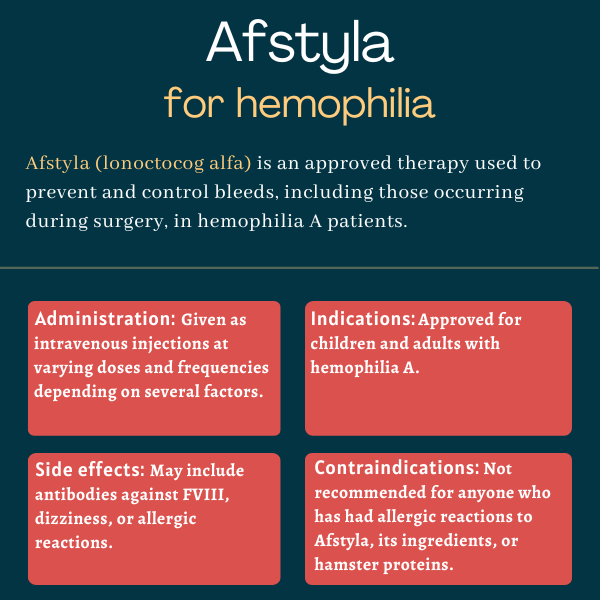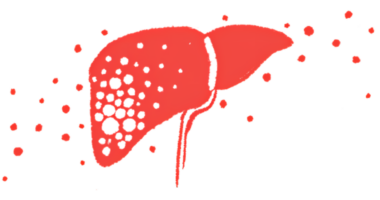Afstyla (lonoctocog alfa) for hemophilia
What is Afstyla for hemophilia?
Afstyla (lonoctocog alfa) is an injectable factor replacement therapy used to prevent and treat bleeding episodes, including those occurring during surgery, in people with hemophilia A.
The therapy, which is administered via an into-the-vein (intravenous) injection, is marketed by CSL Behring.
Therapy snapshot
| Brand name: | Afstyla |
| Chemical name: | Lonoctocog alfa |
| Usage: | Prevention and treatment of bleeds, including those occurring during surgery, in hemophilia A patients |
| Administration: | Intravenous injection |
How does Afstyla work?
Hemophilia A is an inherited bleeding disorder that prevents blood from clotting normally due to the lack of a clotting protein called factor VIII (FVIII). Afstyla contains a recombinant, or lab-made, version of FVIII, that, once activated, works the same way as natural FVIII, thus replacing the missing protein and providing long-lasting bleed protection.
In the therapy, the two molecular chains that normally make up FVIII are tightly bound together to create a single-chain molecule. This molecular shape helps Afstyla to bind more tightly to blood proteins that help prevent its breakdown, prolonging its presence in the bloodstream.
Who can take Afstyla?
Afstyla was approved by the U.S. Food and Drug Administration in May 2016 for adults and children diagnosed with hemophilia A, making it the first and only recombinant FVIII single-chain therapy to be approved for hemophilia A in the country.
The therapy is specifically indicated to prevent bleeds (prophylaxis) or reduce their frequency, control active bleeds (on-demand treatment), and manage bleeds occurring during surgery (perioperative management).
Afstyla was approved by Health Canada in December 2016 for the same indications. The following year, it was approved in Europe and Japan.
Who should not take Afstyla?
Afstyla is contraindicated, or not recommended, for patients who have experienced life-threatening allergic reactions to the active treatment, any of its components, or hamster proteins.
The therapy is also not indicated for the treatment of von Willebrand disease, another inherited bleeding disorder.
How is Afstyla administered?
Afstyla is given via an intravenous injection. It is available as a white or slightly yellow dried powder supplied in single-use vials that should be reconstituted, or diluted, in sterile water using the provided Mix2Vial needle-free reconstitution and transfer system, before being administered.
The medication comes in seven color-coded dose strengths, measured in international units (IUs):
- Orange: 250 IU
- Blue: 500 IU
- Green: 1,000 IU
- Turquoise: 1,500 IU
- Purple: 2,000 IU
- Cool grey: 2,500 IU
- Yellow: 3,000 IU
The dosage and duration of Afstyla treatment will depend on the intended use, the severity of FVIII deficiency, the location and extent of the bleed, and the patient’s clinical condition.
For prophylactic treatment, the medication should be given at the following starting doses:
- 20 to 50 IU per kilogram (IU/kg) of body weight, given two to three times weekly, in patients 12 and older.
- 30 to 50 IU/kg, two to three times weekly, in children under age 12.
For on-demand treatment, Afstyla should be given to maintain FVIII activity levels at or above:
- 20 to 40 IU/deciliter (dL), with dosing every 12-24 hours until the bleed is resolved, in the case of minor bleeds (e.g. uncomplicated joint bleeds, and minor muscle and oral bleeds).
- 30 to 60 IU/dL, with dosing every 12-24 hours until the bleed is resolved, in the case of moderate bleeds (e.g. muscle and joint bleeds, or mild trauma).
- 60 to 100 IU/dL, with dosing every 8-24 hours until the bleed is resolved, in the case of major or life-threatening bleeds (e.g. deep muscle bleeds, bleeding in the brain, fractures, or head trauma).
For minor surgical procedures, such as tooth extraction, Afstyla should be given every 24 hours for at least one day and until healing is achieved, to maintain FVIII activity levels at 30 to 60 IU/dL.
For major surgical procedures, such as joint replacement surgery or surgeries involving the brain, Afstyla should be given every 8-24 hours until healing is achieved to maintain FVIII activity levels at 80 to 100 IU/dL. The therapy should then be given for an additional period of at least seven days to maintain FVIII activity levels at 30 to 60 IU/dL.
Afstyla can be self-administered or administered by a caregiver after proper training from an experienced healthcare provider or hemophilia treatment center. Doses of Afstyla may be adjusted at a healthcare provider’s discretion based on patient response or other clinical factors.
The rate of administration should be adjusted according to the patient’s comfort level, and should not exceed 10 mL per minute.
Afstyla can be stored at room temperature or in the refrigerator for up to three months. If stored at room temperature, the medication should not be returned to the fridge. After reconstitution, Afstyla should be administered immediately or within four hours.

Afstyla in clinical trials
Afstyla’s approvals were supported by data from the AFFINITY clinical development program involving people with severe hemophilia A. The program included two pivotal clinical trials: a Phase 1/3 study (NCT01486927) involving male patients ages 12-65 and a Phase 3 study (NCT02093897) that involved boys under 12.
These studies enrolled a total of 258 previously treated patients (174 adults and adolescents, 84 children) who received Afstyla either as a prophylactic or an on-demand treatment. A total of 226 patients (146 adults and adolescents, 80 children) received prophylactic treatment.
Data showed the median annualized spontaneous bleed rate across the trials was zero among those who received prophylactic treatment with Afstyla. For adults and adolescents treated prophylactically two or three times weekly, the median overall bleed rate was 1.14. In children under 12, the median overall bleed rate was 3.69.
Of the 1,195 bleeds treated in the pivotal studies (848 in adults and adolescents, 347 in children), about 94% of those in adults and adolescents and 96% of them in children were effectively controlled with one or two infusions of Afstyla. About 81% of bleeds in adults and adolescents, and 86% in pediatric patients were effectively controlled by a single infusion.
Among the 13 adolescents and adults who underwent a total of 16 surgical procedures, Afstyla’s ability to stop bleeds was rated as “excellent” in 15 surgeries and as “good” in one procedure.
An open-label Phase 3 extension study (NCT02172950) that enrolled 204 patients treated in previous Afstyla trials and 18 previously untreated patients, was also part of the program.
For patients in this extension study, Afstyla continued to demonstrate a favorable efficacy profile, with a median annualized bleeding rate of 1.21 and a median spontaneous bleed rate of 0.32. Of the 2,413 bleeds treated with Afstyla in the trial, 86.3% were successfully treated with one or two injections, and the treatment’s efficacy was rated as “excellent” in 71% of the bleeds.
Common side effects of Afstyla
The most common side effects associated with Afstyla in clinical trials include:
- FVIII antibodies, or inhibitors, in previously untreated patients
- dizziness
- allergic reactions.
Allergic reactions
Patients may develop allergic reactions to Afstyla, including a severe reaction called anaphylaxis. If symptoms of an allergic reaction occur, including hives, welts, chest tightness, wheezing, low blood pressure, or itching, Afstyla should be stopped and patients should immediately seek medical attention. Patients with a history of allergic reactions may consider pretreatment with antihistamines.
Development of inhibitors
Neutralizing antibodies against FVIII, also known as inhibitors, may develop during treatment with Afstyla, and potentially render the therapy less effective. Previously untreated patients are at greater risk of developing these antibodies.
Patients should be closely monitored for the development of inhibitors. In cases where FVIII activity levels are not attained, or bleeds fail to be kept under control following treatment with Afstyla, the presence of inhibitors should be suspected.
Use in pregnancy and breastfeeding
Afstyla was mostly studied in clinical trials involving male patients, so it remains unknown if the medication can affect a developing fetus, compromise female fertility, pass to breast milk, or have harmful effects on breastfed infants or on milk production.
Patients who are pregnant or breastfeeding should seek medical advice before starting treatment, and those wishing to become pregnant or to breastfeed while on treatment should carefully weigh the potential risks on the fetus or infant.
Hemophilia News Today is strictly a news and information website about the disease. It does not provide medical advice, diagnosis, or treatment. This content is not intended to be a substitute for professional medical advice, diagnosis, or treatment. Always seek the advice of your physician or other qualified health provider with any questions you may have regarding a medical condition. Never disregard professional medical advice or delay in seeking it because of something you have read on this website.
Recent Posts
Related articles

 Fact-checked by
Fact-checked by 




